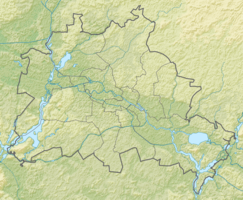Shotgun tower
| Shotgun tower | ||
|---|---|---|
 The shotgun tower in 2005 |
||
| Data | ||
| place | Berlin-Rummelsburg | |
| Client | Juhl and Sons, lead smelter and shotgun factory | |
| height | 38 m | |
| Coordinates | 52 ° 30 '7 " N , 13 ° 28' 46" E | |
|
|
||
The shotgun tower is the landmark of Berlin's Victoriastadt neighborhood . The name is derived from its earlier use as a scrap tower . No shotgun pellets have been made in this tower since 1939 .
Building
The lead foundry and machine factory Juhl & Söhne , owner of the property in Nöldnerstraße (formerly Prinz-Albert-Straße) 15 & 16 since 1901, built the rectangular, 38 meter high brick tower in 1908 as part of the extension of the factory wing to their residential and office building. The tower rises above the roof of the building by 18 meters. The working platform on the upper floor can be reached via 197 steps.
Its façade is in northern Italy towers ajar.
In the GDR the tower belonged as a foundry to VEB Druckguß und Formbau. Until the fall of the Berlin Wall , schoolchildren assembled bicycle odometers in the workshop as part of the productive work subject .
The operating part was under monument protection. With the reunification of Germany, the monument protection was lifted. The house and the tower have been under monument protection since 1994 . Due to extensive damage, the tower was renovated from 1998 to 2000 for 230,000 DM . It is unique of its kind in the Berlin and Brandenburg area.
The tower can be visited at the two regular events Long Night of the Museums and Day of the Open Monument as well as on tours of the Bureau for Industrial Culture.
Shotgun production process
For shotgun production, lead was heated on the top floor of the tower until it became liquid and then poured into a drop tube. In free fall, the lead drops form spheres under surface tension and give off heat to the air that has passed through, causing them to solidify. It is advantageous that this does not create a seam, as is the case with cast shotgun pellets, which has to be filed down before the pellets are used.
After being immersed in the water in the catchment basin, they were rapidly cooled further. Sodium sulfide and oil or tallow were added to the water to protect the lead shot bullets from corrosion .
The windows in the tower were never glazed, but air-permeable wooden slats allowed the heated air and the water vapor to rise and escape in order to obtain good cooling conditions for the lead balls.
After the molding process, the balls were taken from the cooling basin, dried and sorted.
literature
- Siegfried Zucker: The shot ball tower in Rummelsburg. In: Berlinische Monatsschrift 3/1994 at the Luisenstädtischer Bildungsverein , pp. 66–67.
- Winfried Löschburg: Remnants of the Rummelsburg? - a technical monument in Nöldnerstraße. In: Berliner Zeitung , March 20, 1984.
- Volkmar Draeger: Outstanding witness of the city of Victoria . In: Neues Deutschland , October 24, 2005 (report on a tour of the shotgun tower)
- Claudia Fuchs: Nobody is allowed to enter the shotgun tower . In: Berliner Zeitung , December 10, 1998
